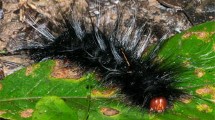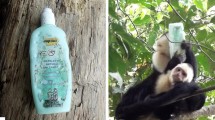Abstract
Defensive secretions of millipedes are remarkable for containing toxic quinones known to efficiently repell hematophagous arthropods. Here we show that Endangered blonde capuchin monkeys make use of such secretions. We (i) describe the anointing behavior performed by the monkeys (ii) identify the millipede species used in the process (iii) describe the volatile chemical composition of its secretion. The blonde capuchin monkeys selectively searched for millipedes hidden under the ground. We observed three bouts of anointing behavior, performed by 13 individuals of all age classes (from adults to independent infants), both solitarily (1 event) and socially (10 events). The only millipede species used by the monkeys is an undescribed species of the genus Poecilocricus (Spirobolida, Rhinocricidae). The volatile chemical composition of the secretions was predominantly comprised of a mixture of benzoquinones and hydroquinones. The social nature of the behavior and time of the observations (mosquito season), suggest that social bonding and mosquito avoidance is linked to the anointing behavior of the monkeys.

Similar content being viewed by others
References
Almeida MA, Cardoso JDC, dos Santos E et al (2014) Surveillance for yellow fever virus in non-human primates in Southern Brazil, 2001–2011: A tool for prioritizing human populations for vaccination. PLoS Negl Trop Dis 8:e2741
Altmann J (1974) Observational study of behavior: sampling methods. Behaviour 49:227–266
Attems CG (1943) Myriapoden von Brasilien, gesammelt von E. Bresslau in den Jahren 1913/14. Senckenb Biol 26:434–458
Attygalle AB, Xu S-C, Meinwald J, Eisner T (1993) Defensive secretion of the millipede Floridobolus penneri. J Nat Prod 56:1700–1706
Baker M (1996) Fur rubbing: Use of medicinal plants by capuchin monkeys (Cebus capucinus). American Journal of Primatology 38 (3):263–270
Birkinshaw CR (1999) Use of millipedes by black lemurs to anoint their bodies. Folia Primatol 70:170–171
Blum MS (1981) Chemical Defenses of Arthropods. Academic press, New York
Bodner M, Vagalinski B, Makarov SE, Antić D, Vujisić LV, Leis HJ, Raspotnig G (2016) “Quinone millipedes” reconsidered: evidence for a mosaic-like taxonomic distribution of phenol-based secretions across the Julidae. J Chem Ecol 42:249–258
Bowler M, Messer EJ, Claidière N, Whiten A (2015) Mutual medication in capuchin monkeys–social anointing improves coverage of topically applied anti-parasite medicines. Sci Rep 5:15030
Brockie R (1976) Self-anointing by wild hedgehogs, Erinaceus europaeus, in New Zealand. Anim Behav 24:86–71
Cardoso JLC, Haddad Júnior V (2003) Acidentes por coleópteros vesicantes e outros artrópodes. In: Cardoso JLC, França FOS, Wen FH, Málaque CMS, Haddad Júnior V (eds) Animais peçonhentos no Brasil: biologia, clínica e terapêutica dos acidentes. Sarvier, São Paulo, pp 258–264
De Capitani EM, Vieira RJ, Bucaretchi F, Fernandes LC, Toledo AS, Camargo AC (2011) Human accidents involving Rhinocricus spp., a common millipede genus observed in urban areas of Brazil. Clin Toxicol (Phila) 49:187–190
Dorigatti I, Hamlet A, Aguas R et al (2017) International risk of yellow fever spread from the ongoing outbreak in Brazil, December 2016 to May 2017. Euro Surveill 22:1–4
Dötterl S, Wolfe LM, Jürgens A (2005) Qualitative and quantitative analyses of flower scent in Silene latifolia. Phytochemistry 66:203–213
Enghoff H, Manno N, Tchibozo S et al (2014) Millipedes as food for humans: their nutritional and possible antimalarial value-a first report. Evid Based Complement Alternat Med. https://doi.org/10.1155/2014/651768
Fernandes NCC, Cunha MS, Guerra JM et al (2017) Outbreak of yellow fever among nonhuman primates, Espirito Santo, Brazil, 2017. Emerg Infect Dis 23:2038–2041
Fialho M, Valença-Montenegro M, Silva T, Ferreira J, Laroque P (2014) Ocorrência de Sapajus flavius eAlouatta belzebul no centro de Endemismo Pernambuco. Neotrop Primates 21:214–218
Fragaszy DM, Perry S (2003) Towards a biology of traditions. In: Fragaszy DM, Perry S (eds) The biology of traditions: models and evidence. Cambridge University Press, New York, pp 1–32
Haddad Júnior VH, Amorim PC, Junior WTH, Teixeira W, Cardoso JLC (2015) Venomous and poisonous arthropods: Identification, clinical manifestations of envenomation, and treatments used in human injuries. Rev Soc Bras Med Trop 48:650–657
ICMBio (2011) Sumário Executivo do Plano de Ação Nacional para a Conservação dos Primatas do Nordeste. ICMBio-MMA, 8 p
Jefferson JP, Tapanes E, Evans S (2014) Owl monkeys (Aotus spp.) perform self-and social anointing in captivity. Folia Primatol 85:119–134
Kappeler PM, van Schaik CP, Watts D (2012) The values and challenges of long-term field studies. In: Kappeler PM, Watts D (eds) Long-term field studies of primates. Springer, New York, pp 3–20
Klitting R, Gould E, Paupy C, de Lamballerie X (2018) What does the future hold for yellow fever virus? Genes 9:291–318
Hoffman RL (1980) Studies on spiroboloid millipeds. XI. On the status of Spirobolus nattereri Humbert & DeSaussure, 1870, and some species traditionally associated with it (Rhinocricidae). Pap. Avulsos de Zool 33:177–181
Hoffman RL, Golovatch SI, Adis J, de Morais JW (1996) Practical keys to the orders and families of millipedes of the Neotropical region (Myriapoda: Diplopoda). Amazoniana 14:1–35
Lynch Alfaro JWL, Matthews L, Boyette AH et al (2012) Anointing variation across wild capuchin populations: a review of material preferences, bout frequency and anointing sociality in Cebus and Sapajus. Am J Primatol 74:299–314
Makarov SE, Bodner M, Reineke D et al (2017) Chemical ecology of cave-dwelling millipedes: defensive secretions of the Typhloiulini (Diplopoda, Julida, Julidae). J Chem Ecol 43:317–326
Marek PE, Bond JE, Sierwald P (2003) Rhinocricidae Systematics II: The species catalog of the Rhinocricidae (Diplopoda: Spirobolida) with synonymies. Zootaxa 308:1–108
Medeiros K, Bastos M, Jones G, Bezerra B (2019) Behavior, diet, and habitat use by blonde capuchin monkeys (Sapajus flavius) in a coastal area prone to flooding: direct observations and camera trapping. Int J Primatol 40:511–531
Morozov NS (2015) Why do birds practice anting? Biol Bull Rev 5:353–365
Neto H, Scardazan A, Bernardes Filho F, Martins G (2014) Skin lesions simulating blue toe syndrome caused by prolonged contact with a millipede. Rev Soc Bras Med Trop 47:257–258
Peckre LR, Defolie C, Kappeler PM, Fichtel C (2018) Potential self-medication using millipede secretions in red-fronted lemurs: combining anointment and ingestion for a joint action against gastrointestinal parasites? Primates 59:483–494
Possas C, Lourenço-de-Oliveira R, Tauil PL et al (2018) Yellow fever outbreak in Brazil: the puzzle of rapid viral spread and challenges for immunisation. Mem Inst Oswaldo Cruz. https://doi.org/10.1590/0074-02760180278
Rodrigues PE, Rodrigues EN, Ott R (2018) Four new species ofRhinocricus (Diplopoda: Spirobolida: Rhinocricidae) from Brazil. Iheringia. Sér Zool. https://doi.org/10.1590/1678-4766e2018031
Roskov Y, Ower G, Orrell T et al (2019) Species 2000 & ITIS Catalogue of Life, 2019 Annual Checklist. www.catalogueoflife.org/annual-checklist/2019. Accessed 01 July 2019
Shear WA (2015) The chemical defenses of millipedes (Diplopoda): Biochemistry, physiology and ecology. Biochem Syst Ecol 61:78–117
Schubart O (1962a) Novas espécies brasileiras da Família Rhinocricidae (Diplopoda, Opisthospermophora). An Acad Bras Ciênc 34:69–87
Schubart O (1962b) Um Novo Gênero da Família Rhinocricidae da Bahia (Diplopoda, Opisthospermophora). An Acad Bras Cienc 34:265–268
Shpall S, Frieden I (1991) Mahogany discoloration of the skin due to the defensive secretion of a millipede. Pediatr Dermatol 8:25–27
Stanković S, Dimkić I, Vujisić L et al (2016) Chemical defence in a millipede: Evaluation and characterization of antimicrobial activity of the defensive secretion from Pachyiulus hungaricus (Karsch, 1881) (Diplopoda, Julida, Julidae). PLoS ONE 11:e0167249
Valderrama X, Robinson JG, Attygalle AB, Eisner T (2000) Seasonal anointment with millipedes in a wild primate: a chemical defense against insects? J Chem Ecol 26:2781–2790
Valença Montenegro M, Bezerra B, Fialho M, Jerusalinsky L, Lynch Alfaro J, Martins AB (2020). Sapajus flavius. The IUCN Red List of Threatened Species 2020:e.T136253A70612866. https://doi.org/10.2305/IUCN.UK.2020-2.RLTS.T136253A70612866.en. Accessed 21 Sept 2020
Vujisić LV, Makarov SE, Ćurčić BPM, Ilić BS, Tešević VV, Gođevac DM, Vučković IM, Ćurčić SB, Mitić BM (2011) Composition of the Defensive Secretion in Three Species of European Millipedes. Journal of Chemical Ecology 37 (12):1358–1364
van den Dool H, Kartz PD (1963) A generalization of the retention index system including linear temperature programmed gas-liquid partition chromatography. J Chromatogr 11:463–471
Weldon PJ, Aldrich JR, Klun JA, Oliver JE, Debboun M (2003) Benzoquinones from millipedes deter mosquitoes and elicit self-anointing in capuchin monkeys (Cebus spp.). Sci Nat 90:301–304
Xu Z, Stoddart M, Ding H, Zhang J (1995) Self-anointing behaviour in the rice-field rat, Rattus rattoides. J Mammal 76:1238–1241
Zito M, Evans S, Weldon PJ (2003) Owl monkeys (Aotus spp.) self-anoint with plants and millipedes. Folia Primatol 74:159–161
Acknowledgements
This study is a new contribution from the long-term blonde capuchin monkey research conservation project (Projeto Galego). We conducted the study under permit # 25727-1 MMA, ICMBio, SISBIO to Bruna Bezerra. We are thankful to Tronox Pigmentos do Brasil SA, Geraldo Moraes and Virgílio Pinto for essential logistical support in the study site. We also thank Rodrigo Costa, Severino Ramos, João Maria, Cristiano Lira and Antonio Pedro for essential field assistance. MB, KM and RFF were funded by FACEPE (Pernambuco Foundation to Support Science and Technology) scholarships while connected to the Projeto Galego (IBPG-0544-2.05/13, IBPG-0225-2.04/15, IBPG-1236-2.05/16) and CAPES (Coordination for the Improvement of Higher-level Education Personnel). AC was funded by CNPq (The Brazilian National Council for Scientific and Technological Development) and CAPES, and AM was funded through CAPES (PNPD Postdoctoral fund) and FACEPE (BCT-0057-2.05/17). The Projeto Galego has so far been supported by Mohamed bin Zayed Species Conservation Fund, Margot Marsh Biodiversity Foundation, Rufford Foundation, FACEPE (BFT-0160-2.04/17; APQ-1534-2.04/10, APQ-0143-2.04/14; BFT-01602.04/17; BFT-0014-2.05/20) and CNPq (Universal 445071/2014-1). BB is supported by a CNPq-Productivity grant (Pq2 309256/2019-4).
Author information
Authors and Affiliations
Corresponding author
Electronic supplementary material
ESM 2
(DOCX 2.79 mb)
Rights and permissions
About this article
Cite this article
Medeiros, K., Campêlo, A., Maia, A.C.D. et al. Wild Blonde Capuchins (Sapajus flavius) Perform Anointing Behaviour Using Toxic Secretions of a Millipede (Spirobolida: Rhinocricidae). J Chem Ecol 46, 1010–1015 (2020). https://doi.org/10.1007/s10886-020-01215-0
Received:
Revised:
Accepted:
Published:
Issue Date:
DOI: https://doi.org/10.1007/s10886-020-01215-0




